Recently, I was approached by a young soldier who wished to upgrade his 1911 pistol. The pistol in question is a Springfield Stainless 1911A1. The pistol was in good shape and had proven reliable and accurate in thousands of rounds of ammunition, but the owner felt limited by the small sights—and he’s among the few shooters genuinely good enough to feel limited by a pistol. I checked the pistol and found it to be a good solid piece well worth an upgrade. Trigger compression was a crisp and clean 4 pounds, overall an above average factory trigger. The pistol fed hollowpoints and exhibited no glaring faults, despite the embryonic sights of the 1911 GI pistol. These sights simply don’t make the grade in a modern-combat/general-purpose pistol.
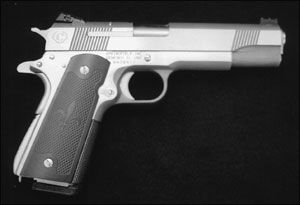
300
The young man also expressed some interest in front-slide serrations and possibly a match-grade barrel. I test fired the pistol under controlled conditions and found the piece capable of five-shot 25-yard groups of 2-1/2 to 3 inches with good handloads and the Winchester SXT service load. I have seen more accurate Springfields, but I’ve also seen worse. (The stainless pistol does seem to be better fitted and is often more accurate than the blued-steel version.)
The only snag in the fabric of my plans was that this was the only pistol the young man owned, and he was loath to be “naked” for weeks while work on his slide was completed. I think many of us have run across this situation. For some customers, time is not that important, but for the “one-gun man” or perhaps a police officer, time (and, of course, reliability) are foremost.
I took a hard look at what he wanted and decided he might be best served with a high-grade custom slide. I’ve had excellent results with Caspian slides, and Caspian offers Novak, Heinie, BoMar, and even GI slide cuts. A new version of their high-grade stainless slide features an external extractor as well. Our young soldier is conversant in the latest trends and felt that if the external extractor could be had, he would have one.
Obviously, if funds had allowed, the purchase of a new Springfield Loaded Model or Professional would of solved most of the problems. But once the plans included a match-grade Bar-Sto barrel, the accuracy of our piece would likely outpace even the best factory-made products. So, we ordered the slide. The specs included a rear slide cut for the new Caspian tactical sight, an adjustable unit far more rugged than most adjustable sights. The front cut would be Novak. The forward cocking serrations popular with special units were specified, along with the external extractor.
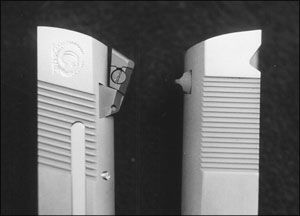
300
You might ask: Why not an upgrade on the frame? The fact is that the young man was quite happy with the lower end. The trigger compression was fine, and he had no problem hitting the slide-lock safety on demand. The Springfield safety is well fitted, tight, and requires enough effort to deploy to be termed service grade. He is one of the lucky ones who has thin strong hands and does not have difficulty depressing the tang safety on demand. No beavertail safety was needed.
I could have installed high-visibility sights such as the King’s Hardballer in the existing dovetail, but the customer wanted a high-vis sight that was adjustable, if one sufficiently rugged could be found. A generation ago I would not have considered adjustable sights. But a competition shooter needs adjustable sights and our shooter wanted his .45 to be an all around service/defense/sporting pistol. The Caspian sight has excellent adjustments, and has proven durable in firing hundreds of full-power rounds.
At about the same time I ordered the slide, Wayne Novak published a press release concerning his new sights. The Novak sight is now available with a fiber-optic insert. The Novak sight is sturdy and the fiber is firmly attached to avoid the problem of losing the fiber in recoil. As for visibility, this sight is optimal for rapid shooting.
When fitting the slide, all went easily in this case. The Caspian usually mates with the Springfield 1911A1 and Colt Series-70 pistols with no fitting required. Occasionally, a minimal amount of work is needed. All that was required was assembly in this case. The external extractor presented no problems. The extractor is one of the parts on the 1911 that occasionally gives me problems—most often, because the pistol has been abused. The original extractor requires hand fitting to properly install. The replacement of an external extractor is more straightforward. The external extractor consists of the extractor, a spring, and the locating pin.
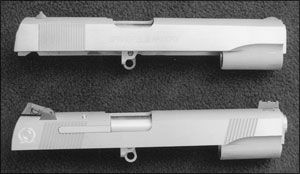
300
To install the extractor, simply point the hook toward the chamber and place the extractor in its slot in the frame over the extractor spring. Then, place the solid pin into its slot in the slide and drive the pin in. The pin is very hard and requires even blows to drive it into place. To install the sights, I used the proven method of lubricating the slots and driving them in. In the unlikely event the slots were a bit loose, I could have peened the slot, but this has never been a problem for me with Caspian slides.
To assemble the pistol, I came up with a list of parts. Some were available from Caspian and others were obtained from Brownells. The list of parts and supplies for this project is shown in Figure 1.
I have to admit I made a mistake, simply from failing to do adequate research. I had ordered a .45-caliber firing pin. The Caspian slide uses a .38 Super-type. There are two types of .38 Super firing pins, Springfield and Colt. These lightweight firing pins are mated with a heavy firing-pin spring to add a margin of safety if the piece is dropped. This keeps the firing pin from taking a run forward under momentum. I was able to get a .38 Super pin shipped to me in record time from Ed Brown Products. The firing-pin stop is a Wilson Combat Hardcore. This part was slightly oversize, which is for the best; an oversize firing-pin stop is not likely to work loose under recoil. A few strokes of the file produced a good fit.
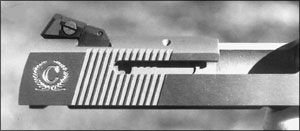
300
The Novak front sight rests in the familiar .330 x .075 x 65-degree Novak cut. A bit of patience is required, and, of course, you should use a padded brass hammer. But there was no difficulty in fitting either the front or rear sights; the Caspian cuts are right on the money. I can’t help but wonder if they ever sell any GI-cut slides with the staked-in front sight, but surely there is someone somewhere who builds “retro .45s.” For this shooter, the modern Novak and Caspian sights are much better suited for all-around use.
After fitting the sights, firing pin, firing-pin stop, and extractor, we were ready for a firing trail. The Springfield barrel, link, recoil guide, springs, and recoil-spring plug functioned in the Caspian slide perfectly, with no need for fitting and no slop. This is how the piece was test fired. The practical accuracy of the pistol was considerably improved, and the owner was quite happy with the improvements. I wish to point out his pistol was never out of service; he simply walked into the shop and the slide was on his pistol in a few minutes. Of course, for the test, the pistol was well lubricated and USA ball ammunition was used.
We decided to “go for the gold” and fitted a Bar-Sto Precision barrel. We needed to fit the barrel, of course, and this required that the pistol be surrendered to me for a few days. But the work went smoothly and, with a minimum of time expended, the piece was back up and running. The barrel was fitted by the proven “cut and try” method; in other words, fit the barrel a bit and give it a try. After the barrel was fitted, the pistol demonstrated accuracy equal to or better than that of any factory pistol. You don’t need extensive frame modification if the upper end is exemplarily in fit, finish, and top-grade components.
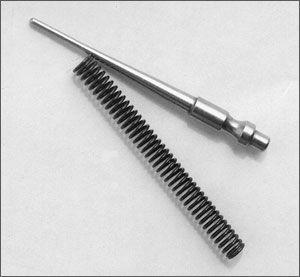
300
A modest break-in was required with lighter target-type loads. Then the piece was broken in with one of my handloads that pushes the Hornady XTP 200-grain bullet to over 1,000 fps. For practice, I like to use loads that are a bit below the hardball range, and the piece now functions with these. The Cor-Bon Performance Match load gave excellent results, as did several of my other handloads and various brands of service-grade ammunition. (See Figure 2.)
When considering any modification that entails working with the slide area, I think the option of purchasing a quality custom slide is a good one. The ease of modification—comparatively speaking—and the economy of time strongly recommend this option. The pistol illustrated in this report demonstrates that this course is well worthwhile.
In conclusion, I was pleased to note that the tang safety was free of the sharp edges found on some pistols, and the arched housing and short trigger gave good results. Overall, I’m very happy with the fit and feel of the Springfield piece. Personally, I would have fitted an Ed Brown beavertail safety, but as long as the shooter was happy with what he had, this was not necessary




























